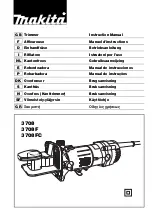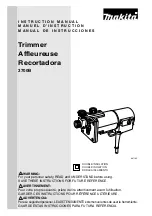
GB
- 259 -
oil, sharp edges and moving parts of the appliance.
Dama-
ged or entangled cables increase the risk of an electric shock.
e) If you are working outdoors with an electric tool, only use
extension cables which are designed speci
fi
cally for this
purpose.
Using specially designed outdoor extension cables, the
risk of electric shock is reduced.
f) If operation of the electric tool in a damp environment can
not be avoided, use a earth-leakage circuit-breaker.
The
earth-leakage circuit-breaker reduces the risk of an electric shock.
3. Safety of persons
a) Be careful, watch what you are doing and use an electric
tool sensibly. Do not use the tool if you are tired or under
the in
fl
uence of drugs, alcohol or medication.
A moment of
inattention when using the electric tool can result in serious inju-
ries.
b) Wear personal protection equipment and always wear sa-
fety goggles.
Wearing personal protection (such as dust masks,
non-slip safety shoes, safety helmet or ear protection, depending
upon the type and use of the electric tool) reduces the risk of inju-
ry.
c) Make sure that the appliance cannot start up accidentally.
Ensure that the electric tool is switched o
ff
before you con-
nect it to the power supply and/or insert the battery, or pick
up or carry the tool.
If your
fi
nger is on the switch whilst carrying
the electric tool or if you connect the appliance to the mains when
it is switched on, this can lead to accidents.
d) Remove keys and wrenches before switching on the electric
tool.
A tool or key which comes into contact with rotating parts of
the appliance can lead to injuries.
e) Avoid abnormal working postures. Make sure you stand
squarely and keep your balance at all times.
In this way, you
can control the electric tool better in unexpected circumstances.
Anl_PE_AHH_18_Li_Basic_SPK7.indb 259
Anl_PE_AHH_18_Li_Basic_SPK7.indb 259
15.01.16 13:02
15.01.16 13:02
















































